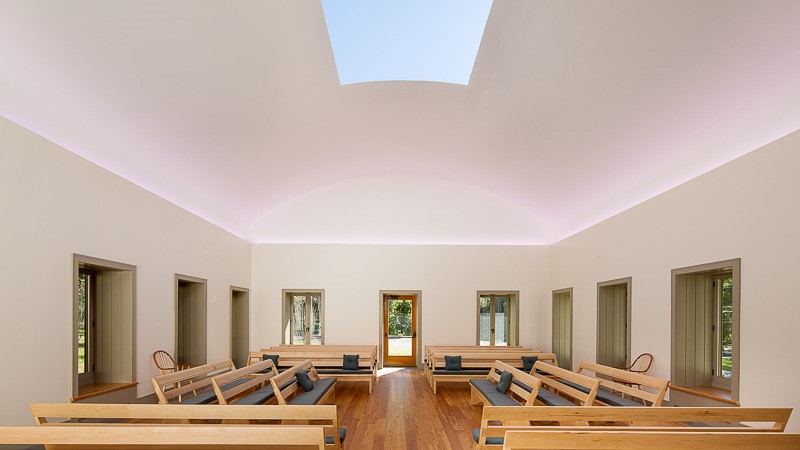
Chestnut Hill Friends Meeting Skyspace photographed by Greg Benson
The Pew Research Center (a subsidiary of The Pew Charitable Trusts) regularly conducts surveys on religion and public life. PYM met with them this year to discuss sharing their articles and research on the PYM Website, and this is our first story featuring their research.
We’ve learned that one out of eight Americans say they attended church in the past month. What do they think about online worship? Below we have excerpted some interesting facts from a series of polls Pew conducted during the pandemic.
Pew reports that for the Americans who attend church, 86% of congregations implemented changed forms of worship to accommodate pandemic conditions, and 79% of churchgoers say “houses of worship should be required to follow the same rules about social distancing and large gatherings as other organizations or businesses in their local area.”
The surveys deal with how people feel about digital worship, what they plan to do in a post-pandemic period, and how they feel about social distancing in churches. All the content below is excerpted from the Pew Research Center’s August 7th story on their website. It is a lengthy article–too long to quote in full. The reporting is nuanced, and captures important facts about American attitudes. We suggest reading the full article.
How many Americans are attending religious services in person or online?
Overall, about half of U.S. adults who typically attended religious services at least once a month in 2019 (49%) appear to have substituted virtual participation for in-person attendance: They have recently watched services online or on television and have not attended in person.
Roughly a quarter of regular worship attenders (23%) appear to be supplementing in-person attendance with virtual participation: They have both attended religious services and watched them online or on TV in the last month.
Many Americans (are) experiencing virtual services for the first time, (and) experimenting with different congregations.
Slightly more than half of U.S. adults who have watched religious services online or on TV in the last month say that this is something they started doing during the coronavirus outbreak (54%), while 46% say they watched virtual services even before the onset of the pandemic.
Among those who have recently watched religious services online or on TV, majorities of Catholics (68%) and mainline Protestants (62%) say watching virtual church services has been a new experience for them as a result of the outbreak, while most people in the historically Black Protestant tradition (59%) and half of evangelical Protestants say they had done this before.
Fewer than half of those who have watched religious services online or on TV in the past month (40%) say they have watched services offered only by the congregation that they typically attend, while three-in-ten (30%) say they have watched services both from their own congregation and from others.
Overall, nine-in-ten U.S. adults who have recently watched religious services online say they have been satisfied with what they have seen…
Most say their religious attendance habits will revert to pre-pandemic norms
With a wide variety of virtual services available to anyone with an internet connection, many Americans appear to be taking advantage of them and are trying something new.
Overall, 6% of U.S. adults say they anticipate watching religious services online or on TV more often after the pandemic than they did before the pandemic, while 9% say they will watch religious services less often.
More broadly, the survey finds that few U.S. adults who typically attend religious services (6%) say their congregations are open and operating normally, just as they were before the onset of the pandemic. Among religious attenders, 31% say their congregation is closed altogether, while 55% say their house of worship is open and holding religious services, but with modifications as a result of the outbreak.
(Of) people who say that their house of worship is open with modifications, 82% say their house of worship requires people to stay at least 6 feet apart.
There … are broad racial and ethnic differences: White Americans have been less affected and are less worried about the effects of the pandemic than are Black and Hispanic Americans.
While the outbreak is not over, the survey suggests that the pandemic will not produce widespread, lasting changes in patterns of attendance at religious services. More than nine-in-ten people who were regular religious attenders before the outbreak (92%) say they intend to resume their previous level of religious attendance or plan to attend religious services even more often once the outbreak is over. And within this group, most say they will watch virtual services either at the same rate or less often than they did before the outbreak.
The Pew Research Center is a nonpartisan fact tank that informs the public about the issues, attitudes and trends shaping the world. They conduct public opinion polling, demographic research, content analysis and other data-driven social science research. They do not take policy positions.